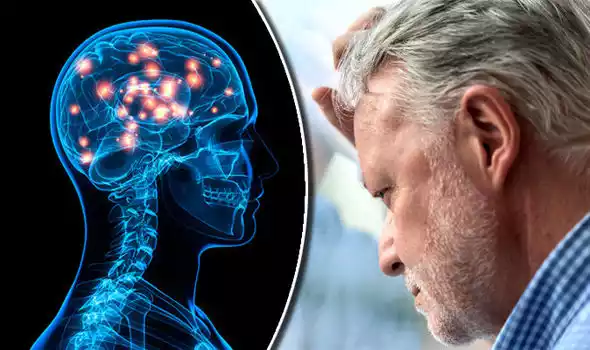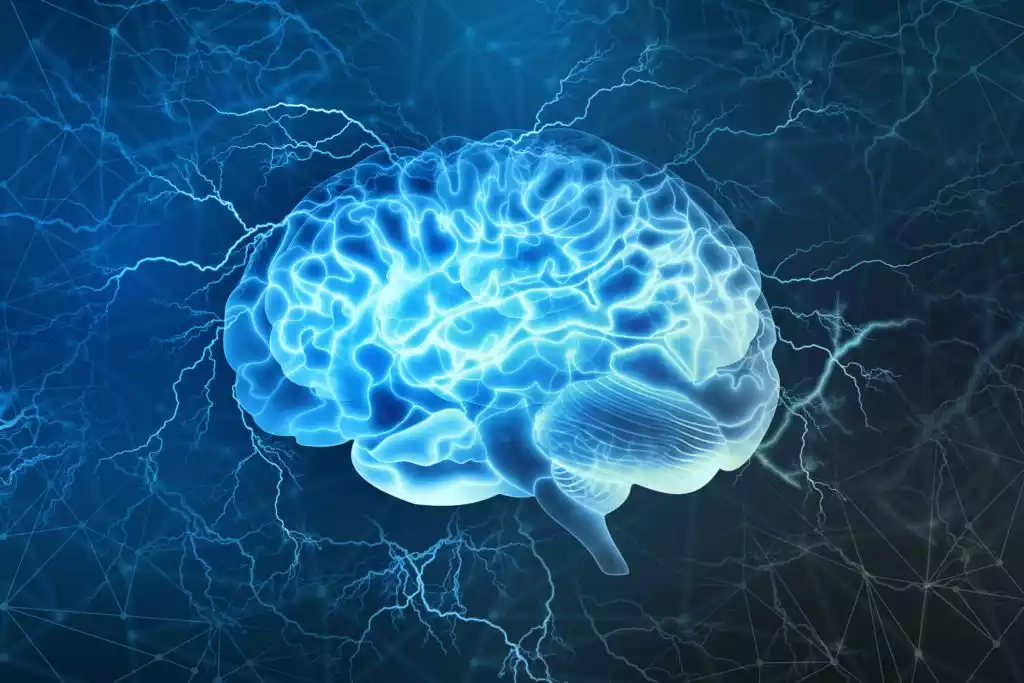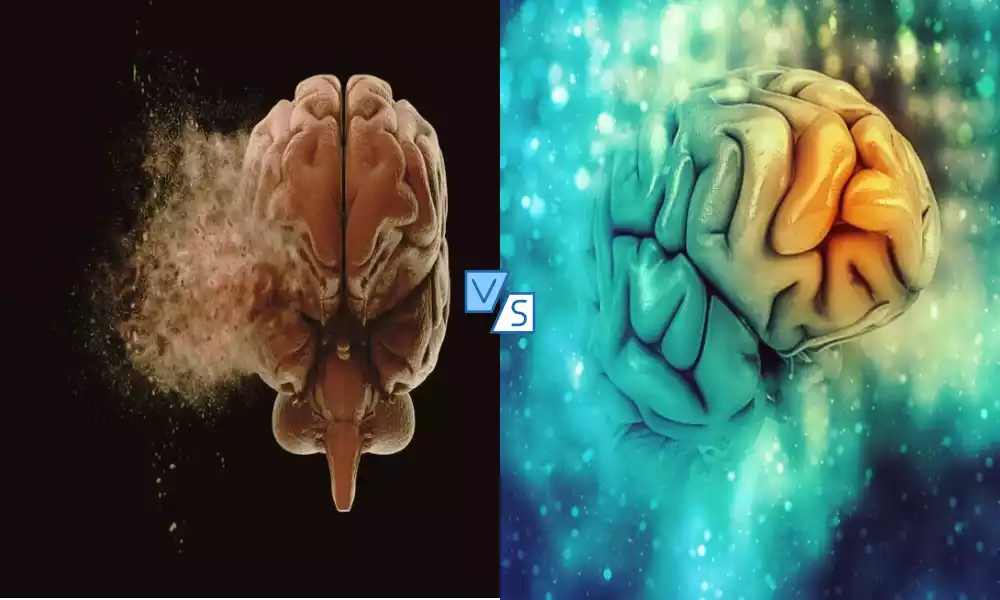Cortical and Subcortical Dementia represent two distinct categories of neurodegenerative disorders, each with its unique characteristics and impact on cognitive function. Cortical dementia primarily affects the cerebral cortex and is often associated with prominent memory deficits, language impairments, and executive function problems. Alzheimer’s disease and frontotemporal dementia are common subtypes.
Subcortical dementia primarily involves subcortical structures like the basal ganglia and thalamus, leading to motor symptoms, mood changes, and slower thinking. Parkinson’s disease dementia and vascular dementia fall into this category. Recognizing these differences is crucial for accurate diagnosis and tailored treatment approaches.
What is Cortical Dementia?

Cortical dementia refers to a group of neurodegenerative disorders that primarily affect the cerebral cortex, the outer layer of the brain responsible for complex cognitive functions. The most common forms of cortical dementia include Alzheimer’s disease and frontotemporal dementia.
In cortical dementia, the brain’s neocortex, responsible for memory, language, decision-making, and problem-solving, gradually deteriorates due to the accumulation of abnormal protein deposits and cellular damage. This leads to a range of cognitive deficits, including memory loss, language impairments, and changes in behavior and personality. As the disease progresses, individuals with cortical dementia often require increasing levels of care and support from caregivers and medical professionals.
Diagnosing cortical dementia involves a combination of clinical assessments, cognitive tests, and brain imaging techniques. Treatment approaches typically focus on managing symptoms, slowing disease progression, and improving the individual’s quality of life. While there is currently no cure for cortical dementia, ongoing research aims to uncover the underlying mechanisms and develop more effective interventions to address its various aspects.
Types of Cortical Dementia
Cortical dementia encompasses several distinct types, each with its own characteristic features and underlying causes. The primary types of cortical dementia include:
- Alzheimer’s Disease: This is the most common form of dementia and is characterized by the accumulation of abnormal protein aggregates, such as beta-amyloid plaques and tau tangles, in the brain. Alzheimer’s disease predominantly affects memory and cognitive functions, progressively impairing thinking, reasoning, and problem-solving abilities. As the disease advances, individuals may experience personality changes and difficulty performing everyday tasks.
- Frontotemporal Dementia (FTD): FTD refers to a group of disorders that primarily affect the frontal and temporal lobes of the brain, leading to changes in behavior, personality, and language abilities. Unlike Alzheimer’s, FTD often occurs at a younger age and can lead to socially inappropriate behaviors, apathy, language difficulties, and impaired executive functions.
- Primary Progressive Aphasia (PPA): PPA is a subtype of frontotemporal dementia that specifically targets language functions. Individuals with PPA experience difficulties in speaking, understanding language, and finding the right words to express themselves. Unlike other forms of dementia, memory remains relatively intact in the early stages of PPA.
- Corticobasal Degeneration (CBD): CBD is characterized by the degeneration of the cortex and basal ganglia, leading to a range of motor and cognitive symptoms. It often presents with movement difficulties on one side of the body (akinetic-rigid syndrome), as well as cognitive impairments like apraxia (inability to perform purposeful movements).
- Progressive Supranuclear Palsy (PSP): PSP is a rare neurological disorder that primarily affects movement control and eye movements due to the degeneration of brainstem structures and the basal ganglia. It leads to symptoms resembling Parkinson’s disease, including balance and coordination problems, along with cognitive impairments.
- Posterior Cortical Atrophy (PCA): PCA is characterized by the degeneration of the occipital and parietal lobes, leading to visual disturbances and spatial awareness problems. Individuals with PCA often experience difficulties recognizing objects and faces, reading, and judging distances.
Each type of cortical dementia has distinct clinical features, underlying pathological changes, and diagnostic criteria. It’s important to accurately diagnose the specific subtype in order to provide appropriate care and support tailored to the individual’s needs.
What is Subcortical Dementia?

Subcortical dementia refers to a category of neurodegenerative disorders that primarily affect the subcortical structures of the brain, located beneath the cerebral cortex. Unlike cortical dementia, which impacts the outer layer of the brain responsible for higher cognitive functions, subcortical dementia targets deeper brain regions associated with motor control, emotion, and basic cognitive processes.
This category includes disorders like Parkinson’s disease dementia and Huntington’s disease, which are characterized by motor impairments, mood changes, and cognitive deficits.
In subcortical dementia, the deterioration of key subcortical structures, such as the basal ganglia, thalamus, and brainstem, disrupts their communication with the cortex, leading to a wide range of symptoms. These symptoms often include movement difficulties, muscle rigidity, tremors, and gait problems.
Subcortical dementia can result in changes in mood, emotional regulation, and cognitive processing speed. Diagnosis typically involves assessing motor symptoms, cognitive functions, and conducting neuroimaging studies to understand the extent of brain damage.
Although there is no cure for subcortical dementia, treatments aim to manage symptoms, improve quality of life, and slow down disease progression. Medications, physical therapy, and lifestyle modifications can play a significant role in addressing motor symptoms and enhancing overall well-being for individuals with subcortical dementia.
Types of Subcortical Dementia
Subcortical dementia encompasses various types of neurodegenerative disorders that primarily affect the subcortical structures of the brain. Some of the main types of subcortical dementia include:
- Parkinson’s Disease Dementia (PDD): This type of dementia is associated with Parkinson’s disease, a progressive movement disorder. Over time, individuals with Parkinson’s disease may experience cognitive decline in addition to the characteristic motor symptoms like tremors, rigidity, and bradykinesia. PDD is characterized by problems with memory, attention, and executive functions. It often develops in the later stages of Parkinson’s disease.
- Huntington’s Disease (HD): Huntington’s disease is a hereditary disorder caused by a genetic mutation that primarily affects the basal ganglia. In addition to motor symptoms such as involuntary movements (chorea), HD leads to cognitive decline, emotional disturbances, and psychiatric symptoms. Memory, reasoning, and decision-making abilities are progressively impaired.
- Normal Pressure Hydrocephalus (NPH): NPH is a reversible cause of subcortical dementia that results from an accumulation of cerebrospinal fluid in the brain’s ventricles. It often affects older adults and is characterized by a triad of symptoms: gait disturbances, urinary incontinence, and cognitive impairments. Treating NPH involves draining excess cerebrospinal fluid through shunt surgery.
- Progressive Multifocal Leukoencephalopathy (PML): PML is a rare viral infection that targets the brain’s white matter, leading to subcortical damage. It primarily affects individuals with weakened immune systems, such as those with HIV/AIDS or undergoing immunosuppressive therapy. PML can cause a range of neurological symptoms, including cognitive impairment and motor deficits.
- Multiple System Atrophy (MSA): MSA is a progressive disorder that affects both motor functions and autonomic nervous system control. It can be divided into two main subtypes: MSA with predominant parkinsonism (MSA-P) and MSA with predominant cerebellar ataxia (MSA-C). Cognitive impairments, including problems with memory and executive functions, can also occur in MSA.
- Creutzfeldt-Jakob Disease (CJD): CJD is a rare and rapidly progressing neurodegenerative disorder caused by abnormal proteins called prions. It leads to a wide range of neurological symptoms, including cognitive decline, muscle stiffness, and coordination problems.
These types of subcortical dementia are characterized by distinct clinical features, underlying pathological changes, and diagnostic criteria. Early and accurate diagnosis is essential to providing appropriate care and support to individuals with these conditions.
Comparison Table of Cortical and Subcortical Dementia
Here’s a comparison table highlighting the key differences between cortical and subcortical dementia:
| Aspect | Cortical Dementia | Subcortical Dementia |
|---|---|---|
| Primary Brain Regions Affected | Outer layers of the cerebral cortex | Subcortical structures beneath the cortex |
| Main Cognitive Impairments | Memory loss, language difficulties, behavioral changes | Motor impairments, mood changes, cognitive slowing |
| Representative Disorders | Alzheimer’s disease, Frontotemporal dementia, Primary Progressive Aphasia | Parkinson’s disease dementia, Huntington’s disease, Normal Pressure Hydrocephalus |
| Motor Symptoms | Less pronounced or absent | Prominent, including tremors, rigidity |
| Impact on Movement | Minimal to moderate | Significant motor difficulties |
| Common Mood Changes | Often less affected | Emotional disturbances common |
| Progression Rate | Variable, but generally gradual | Variable, can be relatively rapid |
| Age of Onset | Typically later in life | Can occur at different ages, depending on the disorder |
| Language Impairments | Not a primary feature | Generally intact or less affected, except in specific cases like Primary Progressive Aphasia |
| Memory Impairments | Prominent feature | May occur, but not always the focus |
| Brain Imaging Findings | Cortical atrophy, beta-amyloid plaques, tau tangles | Subcortical changes, sometimes including brainstem and basal ganglia abnormalities |
| Treatment Approaches | Focus on managing cognitive symptoms, supportive care | Management of motor symptoms, cognitive and emotional symptoms, supportive care |
| Genetic Linkage | In some cases, genetic factors are associated | Genetic mutation often associated with specific disorders, like Huntington’s disease |
This table provides a general overview, individual cases of both cortical and subcortical dementia can exhibit variations in symptoms and progression. It’s important to consult medical professionals for accurate diagnosis and tailored treatment plans.
Diagnostic Approaches for Cortical and Subcortical Dementia

The diagnostic approaches for cortical and subcortical dementia involve a combination of clinical assessments, cognitive tests, and imaging techniques. Here’s an overview of the diagnostic process for both types of dementia:
Diagnostic Approaches for Cortical Dementia:
-
- Clinical Assessment: A thorough medical history is taken, including information about the onset and progression of symptoms. The clinician evaluates cognitive and behavioral changes, as well as any relevant medical conditions.
- Cognitive Testing: Various standardized cognitive tests are administered to assess memory, language, reasoning, and other cognitive functions. These tests help identify patterns of impairment and determine the extent of cognitive decline.
- Neuroimaging: Imaging techniques such as magnetic resonance imaging (MRI) and positron emission tomography (PET) scans can reveal structural changes in the brain. MRI may show cortical atrophy or changes in specific brain regions associated with different types of cortical dementia.
- Biomarker Analysis: Biomarkers, such as levels of beta-amyloid and tau proteins in cerebrospinal fluid, can provide insights into the underlying pathology, aiding in the differentiation of different forms of cortical dementia, particularly Alzheimer’s disease.
- Genetic Testing: Genetic tests can help identify specific gene mutations associated with certain types of cortical dementia, such as frontotemporal dementia.
Diagnostic Approaches for Subcortical Dementia:
-
- Clinical Assessment: A comprehensive clinical evaluation examines motor symptoms, cognitive changes, and emotional disturbances. A detailed history helps to identify the progression of symptoms.
- Motor Assessment: Assessments of motor function and coordination are crucial for identifying movement-related disorders such as Parkinson’s disease dementia and Huntington’s disease.
- Cognitive Testing: Similar to cortical dementia, cognitive tests are used to evaluate memory, attention, and executive functions. Cognitive slowing is a common feature in subcortical dementia.
- Neuroimaging: MRI and other imaging techniques can detect structural changes in subcortical brain regions, such as the basal ganglia, providing insights into the extent of damage.
- Genetic Testing: In cases like Huntington’s disease, a genetic test can confirm the presence of the mutated gene responsible for the disorder.
- Functional Imaging: Functional imaging techniques like single-photon emission computed tomography (SPECT) or functional MRI (fMRI) can show how brain regions are functioning and communicating, aiding in diagnosis and differentiation.
- Response to Treatment: Sometimes, a positive response to specific treatments (such as Parkinson’s disease medication) can provide additional diagnostic clues.
It’s important to note that the diagnostic process for both cortical and subcortical dementia may involve a multidisciplinary team, including neurologists, neuropsychologists, radiologists, and other specialists, to accurately differentiate between various types of dementia and tailor treatment plans accordingly.
Potential Management Strategies
Management Strategies for Cortical Dementia:
- Medications: Certain medications, such as cholinesterase inhibitors and memantine, can help manage cognitive symptoms and slow the progression of cognitive decline in diseases like Alzheimer’s.
- Cognitive Rehabilitation: Cognitive training programs and therapies aim to maintain cognitive function and improve daily life activities.
- Behavioral Interventions: Addressing behavioral and psychological symptoms through behavioral therapy, psychoeducation, and environmental modifications.
- Supportive Care: Providing a safe and comfortable environment, along with support for daily activities, is essential for maintaining quality of life.
- Caregiver Support: Educating and supporting caregivers helps them manage challenges and maintain their well-being.
Management Strategies for Subcortical Dementia:
- Medications: Parkinson’s disease medications like levodopa can help manage motor symptoms in conditions like Parkinson’s disease dementia.
- Physical Therapy: Exercise and physical therapy can improve mobility, balance, and muscle strength.
- Occupational Therapy: Occupational therapists can help individuals adapt to difficulties in daily tasks.
- Speech and Language Therapy: Beneficial for addressing communication challenges in cases like Parkinson’s disease dementia and Huntington’s disease.
- Psychological Support: Addressing emotional and psychological changes through counseling and therapy.
- Support Groups: Connecting individuals with similar conditions fosters mutual support and sharing of coping strategies.
- Medication Adjustments: Regular monitoring and adjustments of medications can help manage motor symptoms and improve quality of life.
- Lifestyle Modifications: A healthy diet, regular exercise, and adequate sleep contribute to overall well-being.
Remember that management strategies should be tailored to the individual’s specific diagnosis, symptoms, and needs. Consulting with medical professionals and specialists is essential for developing an effective management plan for both cortical and subcortical dementia.
The Importance of Early Detection and Intervention
The importance of early detection and intervention in dementia cannot be overstated, as it has a profound impact on the well-being of individuals and their caregivers.
Here is why early diagnosis and intervention is of such great significance:
1. Accurate Diagnosis: Early detection allows for a more accurate diagnosis, which is essential for identifying the specific type of dementia. This leads to tailored treatment plans and appropriate management strategies.
2. Maximizing Treatment Benefits: Many interventions, such as medications and cognitive therapies, are more effective when initiated early. They can slow down disease progression, alleviate symptoms, and improve overall quality of life.
3. Providing Support: Early diagnosis allows individuals and families to access support services, educational resources, and community networks. This helps them understand the condition, plan for the future, and make informed decisions about care.
4. Delaying Functional Decline: Timely interventions can help delay the onset of severe cognitive and functional impairments. This enables individuals to maintain independence in daily activities for a longer duration.
5. Enhancing Caregiver Preparedness: Early detection gives caregivers more time to learn about the condition, acquire caregiving skills, and build a support network. This reduces caregiver stress and enhances their ability to provide optimal care.
6. Facilitating Future Planning: Early intervention allows individuals to make important decisions about legal, financial, and healthcare matters while they are still capable of doing so.
7. Enabling Clinical Trials: Early detection enables individuals to participate in clinical trials and research studies aimed at testing new treatments and interventions. This contributes to advancing our understanding of dementia and developing more effective therapies.
8. Reducing Healthcare Costs: By addressing symptoms early and managing the condition effectively, the burden on healthcare systems and associated costs can be reduced.
9. Improving Quality of Life: Early intervention helps individuals maintain social connections, engage in meaningful activities, and experience a higher quality of life despite the challenges of dementia.
10. Empowering Individuals: Early detection empowers individuals to actively participate in their care decisions and communicate their preferences for future care.
Early detection and intervention play a pivotal role in enhancing the lives of individuals with dementia and their caregivers. It provides the opportunity to implement strategies that can slow disease progression, manage symptoms, and promote a higher level of functioning and well-being. It’s crucial for healthcare professionals, caregivers, and communities to prioritize early awareness, screening, and support for individuals at risk of or already experiencing dementia.
Challenges and Future Directions in Dementia Research
Challenges in Dementia Research:
- Early Diagnosis: Early detection remains challenging, particularly for some types of dementia. Biomarkers and diagnostic tools need further refinement to enable accurate diagnosis in the preclinical stages.
- Disease Heterogeneity: Dementia encompasses a range of disorders with varying causes and manifestations, making it complex to identify common mechanisms and develop universal treatments.
- Limited Treatments: There is no cure for most forms of dementia. Current treatments focus on symptom management rather than addressing the underlying causes.
- Clinical Trials: Developing effective therapies is hindered by the high failure rate of clinical trials due to the complex nature of dementia and the difficulty in recruiting participants.
- Lack of Biomarkers: Reliable biomarkers for tracking disease progression and treatment efficacy are still lacking in many forms of dementia.
- Caregiver Support: Caregivers face immense challenges, including emotional stress, financial burden, and lack of accessible support services.
Future Directions in Dementia Research:
- Early Detection and Prevention: Advancements in biomarker research and neuroimaging could enable early detection, leading to interventions before significant brain damage occurs.
- Precision Medicine: Tailoring treatments based on an individual’s genetic, molecular, and clinical profile holds promise for more effective and personalized approaches.
- Neuroinflammation and Immune System: Exploring the role of neuroinflammation and the immune system in dementia could lead to novel therapeutic targets.
- Drug Development: Continued research into disease mechanisms could identify new drug targets, including those aimed at preventing the accumulation of abnormal proteins in the brain.
- Non-Pharmacological Interventions: Investigating non-pharmacological interventions such as cognitive training, lifestyle modifications, and social engagement for their impact on delaying cognitive decline.
- Digital Technologies: Leveraging technologies like artificial intelligence and wearable devices for early diagnosis, monitoring, and improving the quality of life for individuals with dementia.
- Big Data and Collaboration: Large-scale data sharing and collaborative efforts among researchers could accelerate discoveries and improve the understanding of complex dementia mechanisms.
- Caregiver Support Services: Developing accessible and comprehensive support systems for caregivers, including respite care, counseling, and education.
- Ethical Considerations: Addressing ethical challenges related to genetic testing, informed consent, and end-of-life care in dementia research and treatment.
- Global Awareness and Policy: Increasing public awareness, advocating for dementia-friendly policies, and improving healthcare infrastructure to address the growing global dementia burden.
Dementia research is multidisciplinary and rapidly evolving. By addressing current challenges and focusing on innovative approaches, researchers aim to uncover the underlying mechanisms, improve early detection, and develop effective treatments to ultimately enhance the quality of Alzheimer’s patients and those caring for them must find support living arrangements suitable to their circumstances.
Final Thoughts
Cortical and subcortical dementia are distinct categories with their own symptom profiles and underlying mechanisms. Understanding these differences is crucial for accurate diagnosis, effective management, and improved support for individuals and families dealing with dementia.



